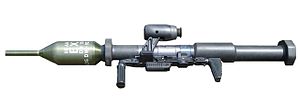Panzerfaust 3

The Panzerfaust 3 is a modern and disposable recoilless anti-tank weapon developed between 1978 and 1985 and put into service by the Bundeswehr in 1992. It was first ordered in 1973 to provide West German infantry with an effective weapon against contemporary Soviet armour thereby replacing West Germany's aging Bazooka-ish rocket launchers.
Principle
The Panzerfaust 3 consists of a disposable launcher tube holding the projectile and a reusable firing and sighting unit. The projectile consists of a shaped-charge warhead filled with Amatol/Syndril and a shaft including the propulsion unit.
The Panzerfaust 3 can be fired from enclosed spaces since it doesn't have a too dangerous a backblast; The rear of the tube, filled with plastic granulate, minimizes the blast effect by the so-called recoilless countermass principle. The booster propellant for the projectile in its tube is ignited by a bolt via a spring mechanism. Once ejected, the rocket motor is ignited.
As safety precautions, the built-in fuse for the warhead is released by a safety mechanism. This arms the warhead after a flight distance of approximately five meters, keeping the crew safe after firing. Once armed, the warhead can explode when it hits a solid object, or when the rocket's propellant runs out. This safeguards against live ammo staying around and causing hazards to all in the future. The Panzerfaust 3's name dates back to the Panzerfaust used by the German Wehrmacht in World War II, but not its operating principle. The World War II weapon was a small recoilless gun firing a round, just like any rifle or gun. It was not a rocket launcher. The US Bazooka was a rocket launcher, as was its German copy, the Panzerschreck.
History
The main drawback is obviously that it has only a single shot and soldiers have to get dangerously close to penetrate heavily armoured targets. Many soldiers also found it very heavy and cumbersome, and its firing mechanism and tube tended to get damaged and jam under battlefield conditions. In addition, the rocket warhead itself was found to be ineffective against heavy armour and armour of newer types and had to be redesigned.
In consequence, the improved PzF 3-T replaced the original model in the late 1990s, introducing a dual hollow charge "tandem" warhead to defeat Explosive Reactive Armour. This means that the spike projecting from the warhead itself also contains an explosive charge to set of the reactive armour and free the path to the real armour for the main warhead. The latest incarnation of the Panzerfaust 3, the PzF 3-IT-600, can be fired from ranges up to 600 meters thanks to an advanced computer-assisted sighting and targeting mechanism.
As of 2005, there were two additional models in the development or testing stage, both relying on smaller and therefore lighter warheads. Those were the RGW (Rückstossfreie Granatwaffe, Recoilless Grenade Weapon - which would make it just like the original in name and operation.) in calibers 60 and 90 millimeters. Both new weapons are expected to help facilitate the transition in German military doctrine from preparation for major tank battles to urban and low-level warfare.
Specifications
There are four different versions of the Panzerfaust 3:
PzF 3
Standard model with hollow charge warhead
- Caliber: 90 mm launcher, 110 mm warhead
- Function: Primarily anti-tank weapon
- Weight: fire-ready weapon : 12.8 kg warhead : 4.0 kg
- Length: 1200 mm
- Muzzle velocity: 165 m/s
- Sights: telescope sights (can be reused)
- Maximum effictive range: 500 m for stationary targets, 300 m for moving targets
- Penetration capability: 700 mm armour, 1.6 metres concrete
- Manufacturer: Dynamit-Nobel, Germany
PzF 3-T
Standard model with dual hollow charge warhead (designed to penetrate reactive armour)
- Penetration capability: PzF 3-T 800 mm armour
PzF 3 Bunkerfaust
Designed for use against hardened bunkers.
- weight: 11 kg
- calibre: 110 mm
- minimum effective range: 11 m
- maximum effective range: 600 m (when fired with DYNARANGE)
- max range with standard sights: 400 m on static targets (300m moving targets)
- penetration capacity:
- rolled homogeneous armour approximately 110mm
- concrete 360mm
- sandbags 1300mm
PzF 3 IT-600
Newest model of the Panzerfaust 3, equipped with tandem warhead and an improved firing and sighting unit called DYNARANGE. The DYNARANGE uses the advanced targeting mechanism Spa-Simrad IS-2000 to calculate weapon elevation and lead angle correction.
DYNARANGE is a part of the Bundeswehr's Infantryman of the Future program.
- Caliber: 60 mm launcher, 110 mm warhead
- Function: Primarily anti-tank weapon
- Weight: fire-ready weapon : 15.1 kg warhead : 4.3 kg
- Length: 1400 mm
- Muzzle velocity: 150 m/s
- Armament: 120 g Amatol/Syndril Warhead - hollow charge or dual (tandem) hollow charge
- Sights: telescopic sights (can be reused, can also be fitted with 4x-16x ACOG/AWA Zoom Scopes)
- Maximum effective range: up to 600 meters (static and moving targets)
- Penetration capability: 900 mm armour, ? meters concrete
Notes
The Panzerfaust 3 is distributed in a special package including spare parts and a cleaning kit. The package contains a launcher, ejector and spring, extractor, dummy extractor plug, bolt-head retaining pin, plastic cleaning rod with brass tip, bore and chamber brushes, camel's hair brush and a prismatic bore scope. It takes several minutes to assemble and load the launcher.
